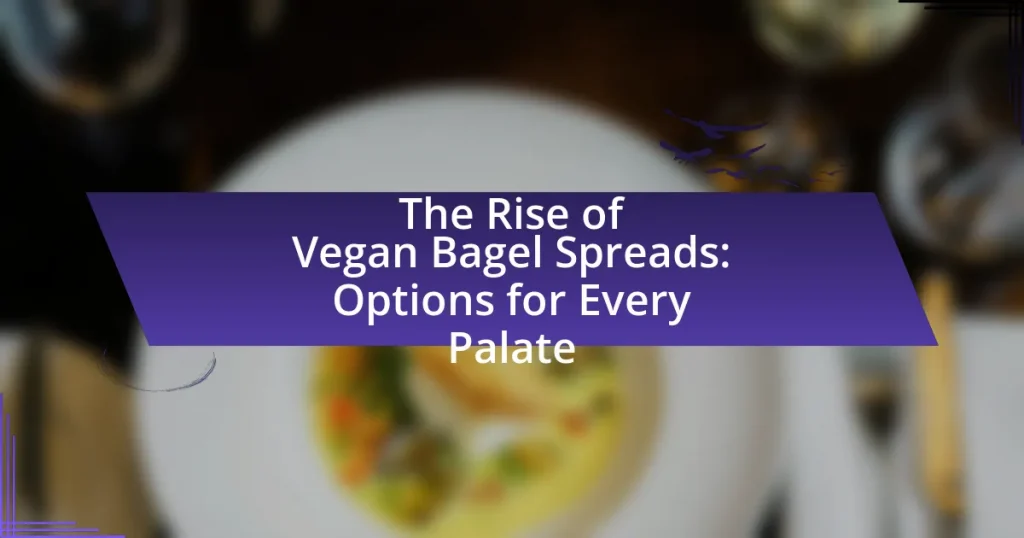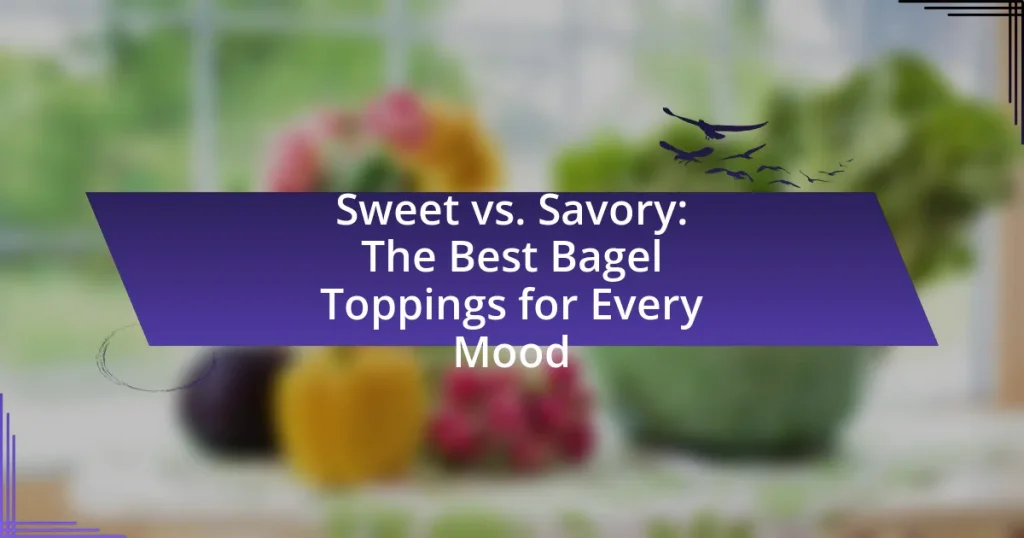The article examines the history of bagel toppings, tracing their origins from early 20th-century Jewish immigrant communities in the United States to contemporary culinary trends. It highlights traditional toppings such as cream cheese, lox, and capers, which reflect Jewish culinary practices, and discusses how these have evolved over time to include innovative and trendy options like avocado and hummus. The article also explores the cultural significance of bagel toppings within Jewish cuisine, the influence of globalization on modern toppings, and current trends in artisan bagel shops, emphasizing the diverse and adaptable nature of this popular food item.

What is the history of bagel toppings?
The history of bagel toppings dates back to the early 20th century when Jewish immigrants in the United States popularized the bagel, originally a simple bread product often topped with sesame or poppy seeds. As bagels gained popularity, particularly in New York City, a variety of toppings emerged, including cream cheese, lox, and various spreads, reflecting the cultural influences of the immigrant communities. By the 1960s and 1970s, bagel toppings expanded further with the introduction of flavored cream cheeses and innovative combinations, such as vegetables and smoked fish, showcasing a blend of traditional and modern culinary practices. Today, bagel toppings range from classic options to trendy ingredients like avocado and specialty spreads, illustrating the evolution of this beloved food item over time.
How did traditional bagel toppings originate?
Traditional bagel toppings originated from Jewish culinary practices in Eastern Europe, particularly among Ashkenazi Jews. These toppings, such as cream cheese, lox, and various spreads, were influenced by local ingredients and customs, reflecting the dietary preferences and available resources of the region. For instance, cream cheese became popular in the early 20th century in the United States, adapting from the traditional cheese spreads used in Europe. The combination of bagels with toppings like smoked salmon and capers emerged as a staple in Jewish delis, particularly in New York City, where the immigrant population sought to maintain their cultural heritage while integrating into American society.
What are the most common traditional bagel toppings?
The most common traditional bagel toppings include cream cheese, lox (smoked salmon), capers, red onion, and tomato. These toppings have historical significance in Jewish cuisine, particularly in New York City, where bagels became popular in the early 20th century. Cream cheese is often paired with lox, creating a classic combination that highlights the flavors of both ingredients. Capers and red onion add a savory and tangy contrast, while tomato provides freshness. This combination of toppings reflects the cultural heritage and culinary practices surrounding bagels.
Why were these toppings popular in specific cultures?
Bagel toppings gained popularity in specific cultures due to historical, geographical, and social factors. For instance, in Jewish culture, traditional toppings like cream cheese and lox became staples because of the dietary customs and the availability of smoked fish in Eastern European Jewish communities. Similarly, in New York, the bagel’s association with Jewish immigrants led to the widespread adoption of these toppings, reflecting the cultural significance of food in community identity. The rise of artisanal bagel shops has also introduced diverse toppings, influenced by local tastes and culinary trends, further embedding these toppings into the cultural fabric of various regions.
What role did bagel toppings play in Jewish cuisine?
Bagel toppings are integral to Jewish cuisine, enhancing the flavor and cultural significance of the bagel. Traditionally, toppings such as cream cheese, lox, and various spreads reflect the culinary practices and preferences of Jewish communities, particularly in Eastern Europe. These toppings not only provide taste but also symbolize the communal and celebratory aspects of Jewish meals, often served during gatherings and holidays. The historical context shows that bagels, originally a simple bread, evolved into a versatile dish with toppings that represent Jewish identity and heritage, making them a staple in Jewish culinary tradition.
How did bagel toppings evolve within Jewish communities?
Bagel toppings evolved within Jewish communities primarily through cultural exchange and adaptation to local ingredients and tastes. Initially, traditional toppings included simple options like cream cheese and lox, reflecting the dietary customs and available resources of Eastern European Jewish immigrants. Over time, as Jewish communities settled in diverse regions, they incorporated local flavors and ingredients, leading to a broader variety of toppings such as capers, tomatoes, and various spreads. This evolution was influenced by the fusion of Jewish culinary traditions with those of other cultures, particularly in urban centers like New York City, where bagels became a staple food. The rise of gourmet bagel shops in the late 20th century further diversified toppings, introducing innovative combinations and flavors, thus transforming the bagel from a traditional food into a trendy culinary item.
What significance do bagel toppings hold in Jewish traditions?
Bagel toppings hold significant cultural and culinary importance in Jewish traditions, reflecting the community’s history and values. Traditional toppings such as cream cheese, lox, and capers are not only staples in Jewish cuisine but also symbolize the blending of flavors and influences from various cultures, particularly Eastern European Jewish immigrants. The choice of toppings often varies by region and occasion, with certain combinations being associated with specific holidays or gatherings, thereby reinforcing communal bonds and shared heritage. For example, the pairing of bagels with smoked fish is a practice rooted in Jewish dietary laws and customs, highlighting the importance of food in cultural identity and religious observance.

How have bagel toppings changed over time?
Bagel toppings have evolved significantly from traditional options to more diverse and trendy selections. Historically, bagels were commonly topped with simple ingredients such as cream cheese, lox, and butter, reflecting the Jewish culinary traditions of Eastern Europe. Over time, particularly from the late 20th century onwards, the variety of toppings expanded to include innovative combinations like avocado, hummus, and various gourmet spreads, influenced by broader culinary trends and dietary preferences. This shift is evidenced by the rise of bagel shops and cafes that offer unique toppings, catering to a wider audience and embracing flavors from different cuisines, thus transforming the bagel from a traditional staple into a versatile canvas for modern culinary creativity.
What are some notable trends in bagel toppings throughout history?
Notable trends in bagel toppings throughout history include the transition from traditional toppings like cream cheese and lox to more diverse and innovative options such as avocado, hummus, and various gourmet spreads. Historically, bagels were primarily topped with simple ingredients, reflecting the cultural influences of Eastern European Jewish communities. In the late 20th century, the rise of bagel shops in the United States introduced a wider array of toppings, including flavored cream cheeses and unique combinations like smoked salmon with capers and red onions. The 21st century has seen a further evolution, with health-conscious trends promoting toppings like avocado and plant-based spreads, as well as the incorporation of international flavors, showcasing the bagel’s adaptability and growing popularity in various culinary contexts.
How did the introduction of cream cheese influence bagel toppings?
The introduction of cream cheese significantly transformed bagel toppings by popularizing a creamy, rich spread that complemented the chewy texture of bagels. This shift led to a variety of toppings being paired with cream cheese, such as smoked salmon, capers, and various vegetables, creating a more diverse and flavorful experience. Historically, cream cheese became widely available in the early 20th century, particularly with the rise of brands like Philadelphia Cream Cheese, which contributed to its integration into bagel culture. This change not only enhanced the taste profile of bagels but also established cream cheese as a staple topping in delis and brunch menus across the United States.
What other toppings gained popularity in the 20th century?
In the 20th century, toppings such as cream cheese, lox, capers, and various flavored spreads gained significant popularity on bagels. The introduction of cream cheese as a standard topping occurred in the early 1900s, with lox becoming a staple in Jewish delis by the mid-century. Capers were often paired with lox and cream cheese, enhancing the flavor profile. Additionally, flavored cream cheeses, including vegetable and herb varieties, emerged in the latter half of the century, reflecting changing consumer tastes and preferences. These toppings contributed to the evolution of bagels from a traditional food to a versatile canvas for diverse flavors.
How have cultural influences shaped modern bagel toppings?
Cultural influences have significantly shaped modern bagel toppings by introducing diverse flavors and ingredients from various cuisines. For instance, the traditional cream cheese and lox combination has been expanded to include toppings like avocado, hummus, and even spicy sriracha, reflecting the growing popularity of health-conscious and global flavors. Additionally, the Jewish immigrant community in New York originally popularized bagels, but as bagels gained popularity across different cultures, toppings such as smoked salmon, capers, and even non-traditional options like peanut butter and jelly emerged, showcasing a fusion of culinary traditions. This evolution illustrates how bagel toppings have transformed from simple, traditional choices to a wide array of innovative and culturally inspired options, driven by globalization and changing consumer preferences.
What international flavors have been incorporated into bagel toppings?
International flavors incorporated into bagel toppings include ingredients such as smoked salmon and cream cheese, which reflect Jewish culinary traditions, as well as capers and dill, commonly found in Scandinavian cuisine. Additionally, flavors like hummus and za’atar represent Middle Eastern influences, while sriracha and avocado showcase Asian and Latin American trends. These diverse toppings illustrate the bagel’s evolution from a traditional Jewish staple to a globally embraced food item, adapting to various cultural tastes and preferences.
How do contemporary bagel shops innovate with toppings?
Contemporary bagel shops innovate with toppings by incorporating diverse and unconventional ingredients that reflect current culinary trends. For example, many shops now offer toppings such as avocado, smoked salmon with cream cheese variations, and even international flavors like kimchi or sriracha. This shift towards unique toppings is supported by consumer demand for novel and gourmet experiences, as evidenced by a 2021 survey indicating that 67% of consumers are interested in trying new flavors on traditional foods. Additionally, the rise of plant-based diets has led to the introduction of vegan cream cheeses and toppings, further diversifying the options available.

What are the current trends in bagel toppings?
Current trends in bagel toppings include a variety of innovative and gourmet options such as avocado, smoked salmon with cream cheese, and specialty spreads like hummus and flavored cream cheeses. These toppings reflect a shift towards healthier and more diverse flavor profiles, appealing to a broader audience. For instance, avocado toast has gained popularity, leading to its incorporation on bagels, while artisanal cream cheeses infused with herbs or spices are increasingly favored. Additionally, plant-based toppings and international flavors, such as kimchi or tzatziki, are becoming more common, showcasing a fusion of culinary influences. This trend is supported by consumer demand for unique and customizable food experiences, as evidenced by the rise of specialty bagel shops that offer a wide range of toppings beyond traditional options.
What are the most popular trendy bagel toppings today?
The most popular trendy bagel toppings today include avocado, smoked salmon, everything seasoning, and cream cheese variations such as whipped or flavored options. Avocado has gained popularity due to its health benefits and versatility, while smoked salmon remains a classic choice that pairs well with cream cheese. Everything seasoning, a blend of sesame seeds, poppy seeds, garlic, and onion, enhances the flavor profile of bagels, making it a favorite among consumers. Flavored cream cheeses, such as herb, jalapeño, or fruit-infused varieties, have also surged in popularity, reflecting a trend towards more diverse and gourmet toppings.
How do health trends influence bagel topping choices?
Health trends significantly influence bagel topping choices by shifting consumer preferences towards healthier options. For instance, the rise of plant-based diets has led to increased popularity of avocado, hummus, and nut butters as toppings, replacing traditional cream cheese. Additionally, the growing awareness of dietary restrictions, such as gluten-free and low-carb diets, has prompted the introduction of alternative toppings like dairy-free spreads and vegetable-based options. Research indicates that 39% of consumers actively seek healthier food choices, which directly impacts the types of toppings offered in cafes and restaurants. This trend reflects a broader movement towards health-conscious eating, shaping the bagel topping landscape.
What unique toppings are emerging in artisan bagel shops?
Unique toppings emerging in artisan bagel shops include smoked salmon cream cheese with dill, avocado spread with chili flakes, and pickled vegetables. These toppings reflect a trend towards gourmet and globally inspired flavors, moving beyond traditional options. For instance, the combination of smoked salmon and dill cream cheese has become popular due to its rich flavor profile and connection to classic brunch dishes. Avocado spread, often enhanced with spices, caters to health-conscious consumers seeking nutritious options. Additionally, pickled vegetables add a tangy crunch, appealing to those interested in bold, vibrant tastes.
How can one create their own bagel topping combinations?
To create your own bagel topping combinations, start by selecting a base flavor, such as cream cheese, hummus, or butter. Next, choose complementary ingredients like vegetables, proteins, or spreads; for example, pairing smoked salmon with cream cheese and capers or using avocado with a sprinkle of salt and pepper. Experimentation is key, as combining different textures and flavors can lead to unique and enjoyable toppings. The versatility of bagels allows for endless combinations, reflecting personal taste preferences and dietary needs.
What ingredients work well together for innovative bagel toppings?
Innovative bagel toppings that work well together include smoked salmon, cream cheese, capers, and dill, creating a classic yet elevated flavor profile. Additionally, combinations like avocado, feta cheese, cherry tomatoes, and a drizzle of balsamic glaze offer a fresh and tangy alternative. Another popular pairing is hummus, roasted red peppers, and arugula, which provides a savory and peppery taste. These combinations are supported by culinary trends that emphasize fresh ingredients and bold flavors, making them appealing in modern cuisine.
How can seasonal ingredients enhance bagel topping options?
Seasonal ingredients can significantly enhance bagel topping options by introducing fresh flavors and textures that align with the time of year. For example, spring offers herbs like dill and chives, which can elevate cream cheese spreads, while summer brings ripe tomatoes and cucumbers that add brightness to bagels. In autumn, ingredients like pumpkin and apple can create unique sweet toppings, and winter allows for hearty options such as roasted root vegetables. The use of seasonal ingredients not only promotes local agriculture but also encourages creativity in flavor combinations, making bagels more appealing and diverse throughout the year.
What tips can help in selecting the best bagel toppings?
To select the best bagel toppings, consider balancing flavors, textures, and nutritional value. A successful combination often includes a spread, protein, and toppings that complement each other, such as cream cheese with smoked salmon and capers. Additionally, incorporating seasonal ingredients can enhance freshness and taste. For example, using ripe tomatoes in summer or roasted vegetables in fall can elevate the bagel experience. Research indicates that diverse toppings not only improve flavor but also increase the overall enjoyment of the meal, as supported by studies on food pairing and sensory evaluation.



